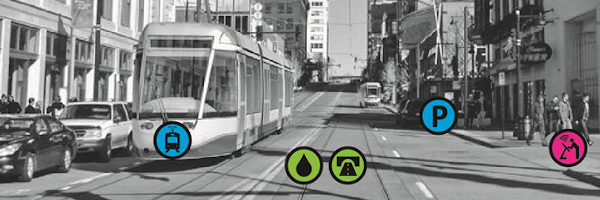Applying Open Data to inform future Smart City Design
| Applying Open Data to inform future Smart City Design | |
|---|---|

| |
 Applying Open Data to inform future Smart City Design | |
| Team Organizations | PlanIT Impact University of Missouri Kansas City Kansas City Design Center |
| Team Leaders | Dominique Davison Praveen Rao Vladimir Krstic |
| Participating Municipalities | Kansas City MO |
| Status | Ready for Public Announcement |
| Document | None |
Description
In order for cities and design professionals to have a more transparent understanding of the Climate Change impacts of potential building development, they must have a tool that provides quick and facile real time calculation linked to the weather data and utility information of an area, along with the potential energy usage. Between March 2016 and 2017:
- We would continue the development of our resource impact estimation tool, PlanIT Impact, to create design specific estimations that can be adjusted in an immersive, 3D digital space for optimal iteration and analysis.
- We would link to local utility data to estimate ROI, creating links with energy usage and green house gas impact, as this will help to inform (and shed light on possible gaps for incentives).
- We would apply this platform to the design and projected energy, water usage and storm water impact on a municipal building project as a prototype and replicable model of how resource impact projection affects actual usage. As an end user of Open Data and Smart City technologies, this also allows the City to showcase and realize the value of this data to their larger constituency.
Challenges
Gaining data from utilities may be a challenge in some areas. Accessing information in a timely manner that is written out in ordinance, to then be translated into a data consumable format is a challenge as well that we are going to have to tackle. Confirming the accuracy of planning data based on the lag on data input into the Open Data portal is something we would work very closely with the City Staff with. Also a challenge might be to be sure that that data is treated in a consistent format. Google Earth is also being deprecated and we need to understand next generation visualization possibilities.
Solutions
TBD
Major Requirements
- Work with Eric Roche, Chief Data Officer of Kansas City, MO, to connect to local utility data, such as KCP&L and the EPA, to have live API connections to be imported to algorithms measuring cost of energy, mix of fuel and other relevant information to Green House gas impact. Eric Roche has expressed support and would be actively assisting in providing the data sets requested and publishing this additional information to the Open Data portal.
- Provide a comparative calculation to ascertain Return on Investment for energy efficient design above code minimum or the addition of on-site alternative energy sources.
- Research the ability to import GIS maps of soil types, which affect stormwater perviousness, that would then be able to be cross referenced by latitude and longitude with any model imported into the site. Such GIS data would vastly benefit from broader bandwidths of networking.
- Develop a data and knowledge management system using Semantic Web technologies to store and process heterogeneous datasets including Open Data. Design algorithms to deal with large-scale data using cluster computing resources. Develop a recommendation engine to guide designers and architects by providing useful feedback during the design phase.
- Beta test the algorithms and the metric outputs with hundreds of building and development scenarios and chart the results. Document the feedback from users and record metrics in expected efficiency and changes in analysis of resource impact.
- Deployment of the tool to the commercial market by first quarter of 2017 with the goal of having 5 cities linked up to PlanIT Impact and a minimum of 24 firms actively using the site.
Performance Targets
| Key Performance Indicators (KPIs) | Measurement Methods |
|---|---|
|
Buildings account for approximately 47% of CO2 emissions in the US. Our long term goal is to reduce this number to 0% over the course of fourteen years, or by 2030, per the 2030 Challenge, which has been adopted by the American Institute of Architects. Our immediate goal is to raise architect and city planner adoption of energy modeling tools by 25% over the next 4 years, as projects that are energy modeled typically expend 20% less energy, and enable 10% of projects to be carbon-neutral and have net zero water impact. The goal from March of 2016 through June 2017 would be to have a municipal building be designed and built according to PlanIT Impact standards that saves 50% more energy than the standard building, saving the tax payer 50% on the cost of operation of that building over time. Another KPI impact for residents with this energy use goal is a reduction in 110 metric tons of carbon dioxide over the course of one year of operation, which equates to 64,000 fewer pounds of coal burned, given the mix of fuels in our area. This impact to the residents of the Kansas City Metro would be further multiplied with every additional building this goal is achieved with moving forward. Water usage and storm water impact goals would also be set at 50% reduction, reducing the impact on the city’s stormwater system and reducing water use by 100,000 gallons annually. |
First, we would measure the time taken to produce similar metrics with traditional practice methods compared with using the advantages of linking to Open & Big data and high speed networking for numerous typical activities for early stage design and planning. This comparison would provide us with a clear measurement of time saved. We know that the first 20% of decisions in the design process have 80% of the resource impact over the life of that building. So focusing on the early stage of design is the most effective in order to achieve net carbon neutrality goals. We would also work with local architecture and planning firms to have them beta test the web platform in their professional practice and request feedback on areas of potential improvement…keeping the focus on the end user and their experience/interaction. We would measure then the actual energy usage and water usage of the structure, once built in Fall 2016-Summer 2017, and report on the actual use. We are in talks with Schneider electric in order to provide sensor data within the building to measure these and provide a dashboard for the users to be able to monitor their usage. Studies show awareness of resource use in real time is very effective in also adjusting human behavior – and can affect utility usage by up to 40%. |
Standards, Replicability, Scalability, and Sustainability
This project will use Semantic Web technologies such as RDF, SPARQL, and OWL, which are standards developed by the World Wide Web Consortium. These standards enable easy data integration of diverse data sources such as Open Data and knowledge representation and reasoning. With a Smart City environment, Open Data, high speed networking, and cloud computing, Kansas City, MO is the ideal city to pilot PlanIT Impact as these are the requirements that optimize use. However, any city would be able to apply this same technology and replicate the work of our team, as we are planning to use the industry best practices and standards. With better Open Data standards in place, PlanIT Impact would be able to operate in any city that publishes API’s to their data, greatly increasing the impact to the Building and Construction industry. As a business model, we have worked out operational costs and plan to continue further development of the platform long-term, as we understand the need in the industry to have access to this technology.
Cybersecurity and Privacy
TBD
Impacts
This project would most importantly contribute to the advancement and disruption of the nearly 1 trillion dollar building and construction industry to meet national goals for climate protection and resiliency. The development of PlanIT Impact would be a realization of the start-up culture that was formulated around Fiber and Smart City infrastructure in Kansas City, MO as well as a proven application of Open Data to benefit the broader population to solve the very real problems of Climate Change and water scarcity. This web-platform would become a self-sustaining business employing dozens of well paid employees and already has the experienced executive leadership in place to be able to launch successfully.
Demonstration/Deployment
- Phase I Pilot/Demonstration:
Our pilot demonstration would include a fully functional .NET, enterprise platform that includes a 3D immersive graphic visualization, showing how a potential building development will look at perform in terms of energy usage, storm water perviousness, and water usage. We would work with the City Architect and Chief Data Officer to apply these data sets and potentially additional ones, such as Building Mix and Parcel data, Green House gas impact and ROI (contingent on funding from other sources) and set work with the design team to execute a building scenario that meets the minimum goal of 50% net impact for energy, water and stormwater – meaning the building will use half the water and energy of a typical building.
- Phase II Deployment:
By June of 2017 the tool, if we are successful in receiving NSF funding, would be fully functional with all of the resource impact modules operable…visualizing potential energy usage, green house gas, ROI, stormwater, water usage and we would have data about adoption in academia and the broader industry to report back on. Without the NSF funding, we would still move forward with the pilot program of running a City project through PlanIT Impact, but might have only basic functionality that is not linked to the City Open Data portal, however the energy and water usage goals would still be measurable. We would pursue funding from private seed investment source for additional data sets.